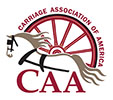
If you’ve ever tried Googling for the history of the Meadowbrook Cart you’ve probably found a distinct lack of information. This dearth of information is because Meadowbrooks used to be classified as a Road Cart and/or Long Island Cart. So where did it all start?
Gigs, two-wheeled carts that were fast and light, were being used in Europe as early as 1791. They were particularly popular with fashionable young men, who viewed them as the sports cars of the day. In America, gigs were also used but there was a need for a lower hung vehicle that was a bit more practical for everyday use. In 1885, Charles A. Ellison of Mineola, Long Island, New York, filed a patent for a cart that would be comfortable for everyday use. His design wasn’t perfect though and it continued to evolve until in 1891 he began advertising the Mineola Cart. Structurally it was a pretty simple cart and was advertised as such:

Your attention is called to the following features of the Mineola which make it the most desirable cart on the market: it carries two passengers; it has an equalizing spring under the front bar that positively prevents any horse motion; one-half of the seat opens out, making it a very easy cart to get out of or into; and does away with the serious objection of having to climb over the shafts or bars; it is in increasing demand for Ladies’ Driving as there is ample protection for their dresses, and the cart is as easy to get into and out of as a phaeton.
The quirky part – this advertisement ran in the Queen County Sentinel on Long Island but the carts were advertised as being built in Whitney Point, NY, some 200+ miles away.
With the basic concept provided by the Mineola Cart, there were several vehicles which followed – Henry M. Willis’ East Williston Cart (1891), the Maplewood Cart from the catalog of J.T. Clarkson & Co (1912) and the Hempstead Cart (1900). Robert H. Nostrand’s Hempstead Cart was originally advertised in The Hempstead Sentinel as ‘the new Meadow Brook Cart’ but due to a feud between Nostrand and fellow Hempstead-based carriage maker David B. Tod, Nostrand’s cart became known as the Hempstead Cart. And then there was Plate No. 30, The Beauty, an ‘ easy-riding road cart’ that came in five different styles from the East Williston Cart Co. The style of theses carts collectively became know as “Long Island.” They rode well over rough ground, were very suitable for use by ladies and they were appropriate for business or pleasure.

Where then did the name Meadowbrook come from? It has been suggested that Long Island Carts became known as Meadowbrook Carts because they were often used to follow the famous Meadowbrook Hounds (NY) through the countryside. The name was certainly established by the time Francis M. Ware wrote “Driving” in 1903, which includes a picture of a early Meadowbrook being driven by a young lady.
What is primary difference between the Meadowbrooks of today and those of the past? The overall design has stayed the same – low-hung, entered via a hinged seat, usually made of natural wood with large fenders – but the shafts have changed. Today’s shafts typically do not absorb as much motion of the horse, lacking the flat or horizontal springs that made the original carts so smooth.

For more information on Meadowbrooks:
Turnout – The CAA Guide to Carriage Turnout and Appointments: Long Island Carts (Meadowbrooks) and Runabouts
History – The Carriage Journal, Vol. 22, No. 1 for The Long Island Carts by Tom Ryder
History – Driving by Francis Ware
Compiled by K. Haak for the Carriage Association of America
Photos from the CAA Archives

